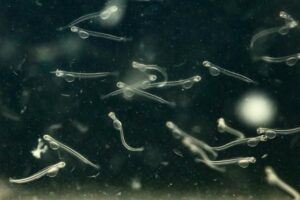Depending on water conditions, MassWildlife plans to stock over 61,000 trout this fall. Approximately 25,000 rainbow trout over 14 inches, 31,600 rainbow trout over 12 inches, and 5,000 brown trout over 9 inches will be stocked. These fish, coupled with the nearly 470,000 trout that were stocked in the spring, should provide for some great fall fishing, according to MassWildlife. The fall stocking season will wrap up around mid-October. Once stocking begins, visit mass.gov/Trout for a stocking report that is updated daily.
Dr. Eve Schlüter named MassWildlife Deputy Director
At its August meeting, the Fisheries and Wildlife Board unanimously voted to promote Schlüter to the position.
Dr. Everose Schlüter (Eve) has been promoted to Deputy Director of the Division of Fisheries and Wildlife (MassWildlife). Schlüter has been with the agency for 16 years and fills the vacancy left when Dr. Jon Regosin retired in March of 2023. This is the first time a woman has been appointed to the role of Deputy Director.
“I’m extremely excited to announce this well-earned promotion,” MassWildlife Director Mark Tisa said after the Fisheries and Wildlife Board approved the promotion. “During her 16 years with MassWildlife, Eve has proven to be an unwavering voice for conservation. Eve’s deep knowledge of science and leadership abilities will be valuable assets to the agency and to all of our constituents.”
Schlüter started working at MassWildlife in 2007 as a reviewer and then advanced to Chief of Regulatory Review in the agency’s Natural Heritage and Endangered Species Program (NHESP). After a two-year stint as Assistant Director for the Massachusetts Environmental Policy Act Office in the Executive Office of Energy and Environmental Affairs, she returned to MassWildlife. Since 2019, Dr. Schlüter has been serving as Assistant Director of NHESP. While in this role, she oversaw all aspects of the program including research, habitat management, rare species restoration, data management, and regulatory reviews of proposed projects under the Massachusetts Endangered Species Act. Highlights from her time as Assistant Director include development of the expanded and upgraded BioMap online planning and conservation tool and representing MassWildlife at state and regional committees and working groups on topic ranging from the impacts of mosquito control and offshore wind projects to wildlife diversity and landscape-level conservation.
“I am grateful, humbled, and excited for this opportunity,” said Schlüter. “I look forward to working with Director Tisa and agency staff to continue advancing the conservation and resiliency of all Massachusetts wildlife and habitats, and to ensure that all Massachusetts residents have access to nature and outdoor recreational opportunities.”
Eve grew up in New Jersey. She received a Ph.D. in Biology and a Certificate in Community Environmental Studies from Tufts University in 2003. She lives with her family in Maynard.
Alice Christman is at it again
As her dad Josh Christman of Pittsfield relates to us, 9-year- old Alice Christman has been grinding in search of her pike this year. “On September 4, we got some live bait, filled up the cooler and took the boat out. Using live bait on a slip bobber, she cast out her line.”
“I was on the phone with a friend who had just called when her bobber went under and the (reel) drag screamed. I told her to set the hook like I taught her. She did it perfectly and fought the fish. Even my buddy who was on the phone that I set down was cheering her on.”
“The pike erupted on the surface and she screamed. I hung off the boat with the net and told her if it runs let it run. (I) couldn’t be more proud of her. I scooped the fish in the net and pulled it up into the boat. I swear you could hear her cheer across the lake. She landed a 42 and a half inch pike weighing 13 pounds, just short of 14lbs.”
It was caught in Berkshire waters. Sorry, I do not disclose the locations of where such big fish are caught; otherwise, no one would tell me about them or show their pictures.
Alice is used to catching large fish. In recent years she has won numerous bronze and gold pins which have been awarded by MassWildlife through its Freshwater Sportfishing Awards Program. In 2019, she was named Angler of the Year in the Youth Catch & Keep Category.
This fish will also be entered in the Youth Catch & Keep Category. But after this year, Alice is going to catch and release her fish.
According to Josh, the pike did not go to waste as a friend likes pike and filleted it up.
Habitat management grant opened September 1
Private and municipal landowners of conserved lands can apply for grant funding to support active habitat management projects that benefit wildlife and enhance outdoor recreation opportunities. MassWildlife’s Habitat Management Grant Program (MHMGP) provides financial assistance for projects that:
- improve habitat for game species (species that are hunted, fished, and trapped),
- manage for State Wildlife Action Plan species (Species of Greatest Conservation Need), with an emphasis on State Endangered, Threatened, and Special Concern species, and
- enhance habitat in ecological communities disproportionally susceptible to climate change.
Although MassWildlife and other conservation organizations have made unprecedented investments in land acquisition in Massachusetts, acquisition alone is not enough to guarantee the persistence of biological diversity. Investment in habitat restoration and management is urgently needed on public and private lands across the state. To address this need, MassWildlife and the Executive Office of Energy and Environmental Affairs have substantially increased their investment in habitat management on state wildlife lands and are committed to working with partners to promote these efforts on conserved lands across the state. Over the past 8 years, the MHMGP has awarded over $2.8M in funding to 40 different organizations and individuals for 105 habitat improvement projects.
Grant applications will be accepted starting September 1 and are due by October 31, 2023. Visit the MHMGP webpage time to learn more about the application process and to see examples of funded projects. For general questions about the grant program, contact James Burnham, Program Coordinator.
Experts from across the state to give presentations focused on local biodiversity
Naturalists and scientists from across the state are coming together for the 14th Annual Berkshire Biodiversity Day, or BioBlitz, which is scheduled for September 23–24 at April Hill Education and Conservation Center, the headquarters for Greenagers, on 62 N Undermountain Rd, South Egremont, MA. This year’s program will feature presentations in addition to guided walks and demonstrations led by experts—all free and open to the public. The four slideshow presentations, which range in topics from spiders to fungi, will each last for approximately half an hour and be followed by a Q&A.
Charley Eiseman presents: “Backyard Leafminers” on Saturday, Sept. 23 at 7 PM
Charley Eiseman will speak about leafminers: insect larvae that spend at least part of their lives feeding between the thin, outer (epidermal) layers of leaves. In North America, they include over 2000 species of moths, flies, beetles, and sawflies, belonging to over 50 different families.
John Wheeler presents: “Local Mushrooms and Their Roles in the Ecosystem” on Saturday, Sept. 23 at 3:30 PM
He’ll go over the symbiotic relationship between plant roots and fungi (mycorrhizal fungi) and mushrooms that get their nutrients by digesting dead or decaying organic matter such as leaves, pine needles, and wood (saprobic fungi).
Joseph Warfel presents: “What is a Spider and What is Not” on Saturday, Sept. 23 at 1:30 PM
Joseph Warfel will give an overview of spiders and their relatives, including brief life histories of arachnids and their place in nature and the global ecosystem.
Aliza Fassler presents: “Meet the Native Bees of New England” on Sunday, Sept. 24 at 10 AM
In North America, there are approximately 4,000 species of wild bees that are critical for pollinating plants in our forests, gardens, and fields.
This year’s event is organized and sponsored by Berkshire Environmental Action Team (BEAT) and Nature Academy of the Berkshires. It’s co-sponsored by Greenagers, Hoffmann Bird Club, Greylock Federal Credit Union, and Panera.
To learn more about this 24-hour biological survey and the scheduled activities, visit www.berkshirebioblitz.org or email team@thebeatnews.org









